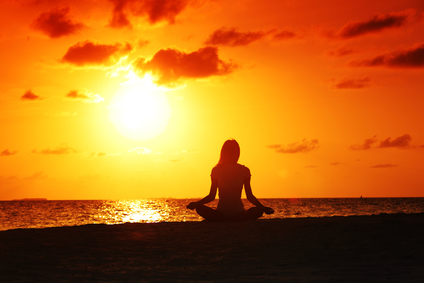|
Meditation

The breath and mind react intimately upon one another. The breath instantly responds
to different mental and emotional states. As the breath flows, so flows the mind. By
concentrating on the breath, the mind becomes calmer. This is the Hong-Sau technique
of concentration and meditation as taught by
Paramhansa Yogananda and also by his
disciple, Swami Kriyananda, the founder and spiritual director of Ananda.
The Hong-Sau Technique:
1)
Energization, prayer, and chanting are suggested before meditation, but Hong-Sau
actually may be done at any time and in any place.
2) Inhale and tense the whole body. Exhale and relax. Repeat three times. Then,
inhale slowly to a count of 6 to 10; hold the breath to that same count; exhale to that
count and immediately inhale again to the same count. Repeat 6-10 times. Please
remember that these are preliminary breathing exercises, not the technique itself.
3) Now, without counting or tension, take a long slow deep breath. When the breath
begins to flow again, begin to observe its movement, without any attempt to control it.
Notice the place at which you can observe the breath in your body whether in the
lungs, in the nostrils, or sinuses. Be an impartial observer, not caring whether it flows
in or out or remains stationary. Simply remain attentive to whatever the breath does
by itself, naturally. Moving the forefinger of the right hand in for inhalation and out
for exhalation may be helpful for helping you tune into the breath.
4) Follow the inhalation with the mantra Hong (pronounced to rhyme with song) and
the exhalation with the mantra Sau (pronounced like saw). Repeat the mantra
mentally only. Be careful not to move the lips or tongue. Hong-Sau is a Sanskrit
mantra meaning I am He or I am Spirit.
5) As your practice deepens, begin to enjoy the pauses between the inhalations and the
exhalations, when the breath is not flowing. Do not actively hold the breath in or out.
As many times as your mind wanders away from Hong-Sau, bring it gently back to the
technique.’
6) After your period of practice of this technique (5-10 minutes is fine for beginners,
gradually increasing the time as you go) inhale and exhale 3 times, and then leave the
breath out as long as is comfortable. Then begin breathing normally.
7) Throughout the practice, keep your eyes closed and looking upward towards the
point between the eyebrows; don’t strain your eyes; let them relax!
8) After completing your practice of Hong-Sau, be sure to sit in silence and stillness for
at least as long as you practiced the technique. Practice devotion, inward chanting,
visualization, or prayer.
PRACTICAL HINTS FOR MEDITATION
Regularity, Set aside the same time or times each day for your meditation.
Recommended are dawn (just after awakening), twilight, high noon, and midnight.
Another is in the evening, just before bedtime. Best always to meditate on an empty
stomach (2-3 hours after meals).
Exercise, If you have time, exercise a little before meditation. Yoga postures are
excellent and of course, Yogananda's
Energization Exercises are highly recommended.
Remember the exercises one does before meditation, should calm, not excite the
nervous system.
Location, Set aside a room, or small part of a room, just for meditation. Try to find as
quiet a spot as possible--or if this is difficult, try using comfortable foam, earplugs or
headphones to block out noise. Be sure the room is not stuffy and a bit on the cool side; a
blanket or shawl to wrap up in is nice. Have a place to sit, and a small, simple altar or
focal point, like pictures, flowers, candles. You will find that the vibrations of meditation
build here. Face East, if possible. Yogis say that there are certain natural currents, flowing
east to west, which help you meditate better. North is also a good direction.
Sitting, Protect yourself from the downward pull of earth currents by sitting on some
natural fiber, like a wool or silk blanket or piece of cloth placed on your meditation chair,
bench, or cushion. Sit erect! A chair is fine, or a comfortable cross-legged position on the
floor or on cushion(s). If you sit in a chair, try not to lean back. Meditation benches are
helpful, too. Whatever your position, keep your back straight, chest raised, head erect,
eyes closed, and hands resting palms upturned, in your lap, preferably at the juncture of
the thighs and abdomen.
How long? Do not set unrealistic goals for yourself. Better to meditate 5-15 minutes
and be very consistent about it, then increase your time as you can. One longer
meditation each week is very helpful. Also it helps to meditate with other people,
especially devotees who have been meditating longer than you have the energy of a
group meditation often helps. you to meditate longer than you would ordinarily be able
to, on your own.
Upon beginning your meditation, say a prayer either out loud, or inwardly, to God and
the Masters, to guide and help you. Do some chanting, if you can (using a cassette tape of
chants is very nice, sing along with it!). Practice breathing to relax. Inhale, tense the
whole body, then throw the breath out and relax, do this 2-3 times.
I’
Then do some measured breathing: inhale to a count, hold that same count, then exhale to the same
count, and begin again, this 6-12 times. The count can be 8-8-8, 12-12-12, or higher if
you feel comfortable. Then relax and breathe normally, but be aware of your breathing.
You should now feel relatively relaxed. Hold the body still! Mentally check it from
time to time to see that no part becomes tensed again inadvertently. Physical tension is a
great deterrent to calm meditations. Be very silent and relaxed, yet aware.
|